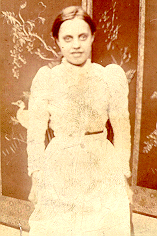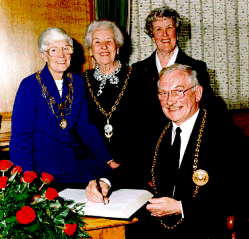 |
Nancy isn't clear whether or not her mother was
attending school regularly but schooling came second to work in those days.
The boarding house, she recalled, was always full of performers, some of
them famous like Hetty King who was renowned as a male impersonator. The
work also had its problems, for Annie had to cross the desolate Newcastle
Moor alone both going to and returning from work. Children would never
be allowed to do that these days.
But of all the stories which Annie told, her favorite was about how
the Germans came to Dawdon. Annie (shown left at about 15 years old) never
gave a reason why she came to Seaham. Perhaps the pressures at home had
become too much. The family was large and it must have been a struggle
for her parents to make ends meet. At least if she, as the eldest, could
find a job and make her own way in life it would help. |
What we do know is that Annie's mother was most concerned that she should
be leaving home to make her own way in the world. But Annie was adamant
that she would cope. She had experience of boarding house work and she
felt certain that she could find a job in Seaham harbour. She set off with
only a coarse apron and a change of underclothes in a tin trunk . These
were her only possessions. At the time, Annie, would only be about 14 or
15 years. But she was determined and insisted that she would find work
in Seaham and would manage to make ends meet.
Annie was no stranger to work. At a very young age, she had been expected
to miss school to "tak' up the bread". This was a common expression used
in NE England at the turn of the century to describe the tedious task of
kneading the dough (to make bread for the whole family of thirteen). So
Nancy came to Seaham Harbour with only a few bare essentials.
As it turned out she found a position as a servant at a large boarding
house at No2, Back North Railway Street close to the docks. The area now
is known as Hawthorn Square.
It was here that Annie met the Germans who had come to Dawdon to sink
the new pit.
Work had begun on August 26th 1899 on the site of Watsontown which
was also known as the Blast Houses. The Marchioness of Londonderry cut
the first sod of grass for theTheresa shaft and Viscount Castlereagh cut
the first sod for the Castlereagh shaft.
The sinking of the pit turned out to be a remarkable feat of engineering.
The Dawdon Colliery site was atop of the cliffs about one mile south of
Seaham Harbour. The major problem expected in sinking the shafts was the
torrents of water which poured through the Magnesian Limestone and Yellow
Sand layers. Provision had been made to pump out up to 7000 gallons of
water a minute.
George Stevenson the "Father of Railways" had made his early reputation
by producing pumps which overcame the water problems of pit sinkers 80
years earlier. But even modern-day pumps were helpless against the endless
torrents which were experienced at Dawdon
The pits had reached a depth of only 361 feet when it became clear
that the flow of water could not be handled by the pumps.Sinking was suspended
on 28th December 1902. The German company Gebbhardt & Koenig of Nordhausen
were contracted to freeze the ground through which the two shafts were
being sunk and also the ground between them. This would allow the sinking
to be carried out without pumping.
Freezing began in May 1903. The ground was frozen to a depth of 484
feet by inserting a ring of tubes into the earth and filling them with
a freezing mixture of lime, ammonia and magnesium chloride. The process
was so successful that when sinking started again in October 1905 it was
necessary to use dynamite to blast through the frozen quicksand and limestone.
By the spring of 1907 the main coal had been reached at a depth of 1321
feet.
Annie Elliott must have heard some fascinating stories from the Germans
she waited on. She always referred to them as "sinkers" but they might
well have been highly skilled "technicians" in todays terms. She often
talked about having to wash their filthy clothes when they returned from
work though.
What we do know is that Annie thoroughly enjoyed her time in Seaham
Harbour. She quickly became a recognised figure in the local community
and regularly attended the Methodist Chapel in Church Street. She became
friendly with a miner called Billy Newcombe and his family (Let us know
if you know of any descendants). Unfortunately, Billy was tragically killed
at the pit.
The Londonderry family who owned the pits was also a regular topic
of her conversation.
She recalled a tragedy at a Sunderland theatre whilst in Seaham. Apparently,
a fire alarm went off and everyone rushed to the doors but they opened
inwards. So great was rush, that a lot of people were crushed. Because
of this tragedy it became law that public doors must open outwards.
Eventually Annie became Head Cook for the Maxwells, a prominent South
Shields family. From there she married Alexander Clark of South Shields
and settle down to give birth to a family of five.
When Annie died in 1974, she was 85 years old.
Her daughter Nancy reflects: "She had always worked and was never idle.
She brought us up to be honest and hard working too."
If you have a story to tell of life and times in Seaham, please
contact us.

Support for this page was provided by the Seaham Project.
This Web site is part of SEAHAM
HARBOUR ON-LINE © 1996
Design and hosting by Dalton
Internet which is part of the Dalton Consultancy Services group
|



